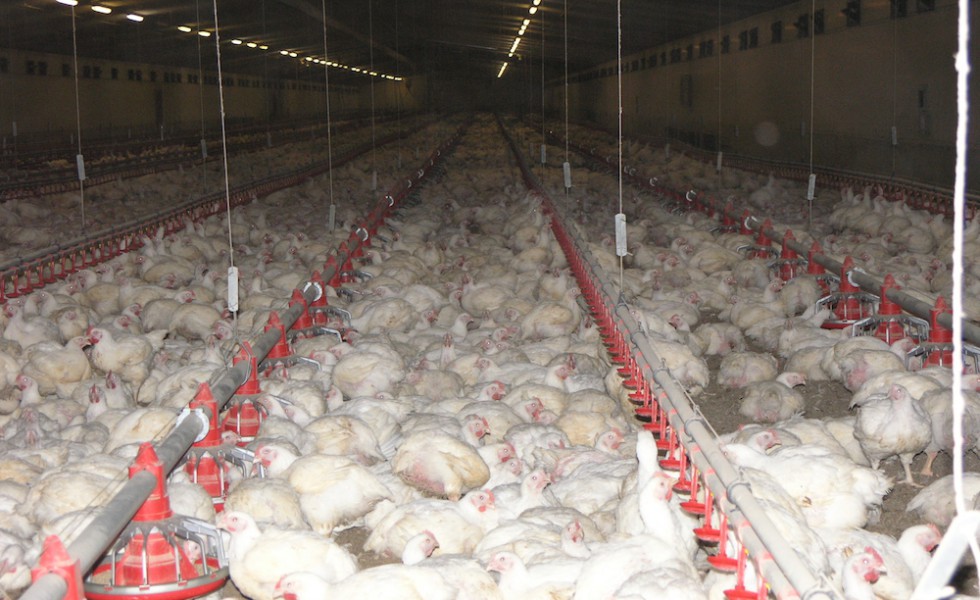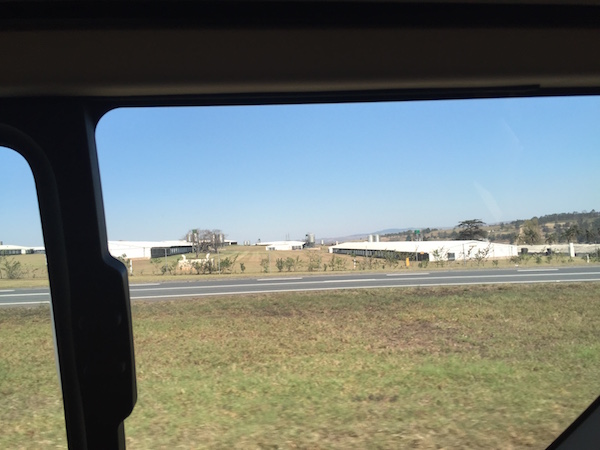
Poultry “Progress” in South Africa and Beyond (Part II)

Inside a South African broiler factory farm (Photo by Free Range Chicken Farming South Africa).
Caroline Wimberly traveled to Durban, South Africa in late August 2015 to attend three conferences on behalf of Brighter Green. Afterwards, she traveled extensively around the country. This blog is the second in a four-part series on her experiences and observations during the trip.
One of the major producers for KFC in South Africa is RCL Foods (previously Rainbow Chicken), which is the country’s largest chicken processor. In 1997, Rainbow Chicken teamed up with U.S. agribusiness Cobb to create Cobb South Africa (now under the umbrella of RCL Foods). This partnership allowed for the introduction of the industry super-breed, Cobb500, into the country. This breed is considered the world’s most “productive” broiler chicken and was developed in the U.K. in the 1970s.
In the style of U.S. poultry giants like Tyson, Rainbow employs vertical integration throughout their supply chain, contracting different growers to provide its poultry products. These providers mimic U.S. growers with factory farm conditions, including indoor confinement of the birds without outdoor access, processed feed, and artificially short life cycles. To give an example of the scale of these growers, here are some production statistics from one Rainbow supplier, Essaurinca from 2013:
- They expanded from 8 sheds to 11 sheds to increase yields and more effectively provide for KFC quota levels (via the Rainbow supply chain);
- Through this expansion, they produced 300,000 broiler chickens per 35-day growing cycle (with about 27,000 birds being raised in each shed);
- They increased from six-and-a-half to eight growing cycles per year, producing around 2.4 million birds per year.
I drove past a few similar poultry sheds, which quite frankly haunted me, as I imagined the huge number of birds crammed inside. These sheds are just outside Durban:
While in South Africa, I had the opportunity to speak to a woman from the U.K. who had worked in multiple broiler and egg-laying factories as an A-level and university student. She came from a rural English town whose main industries were factory farms, and she worked in these facilities over multiple summers to help pay back her student loans. Many students worked at these farms since they were the main employers in town (especially for short-term contract work).
Her shifts were usually 6 AM – 2 PM, and she recalled her duties packing eggs at the battery-cage hen facilities and working the “fried goods line” at the broiler factories. She described the battery-cage factories as “horrendous” and “like a Hitchcock film,” while the poultry processing area of the broiler factories included a dangerous and intimidating deboning section, the most notorious area to work; workers had mini-electrical saws and wore chain mail gloves to protect their hands. While she was never on the kill floor, she saw the carcasses come through to be processed and the “sheer scale was horrific,” she told me.
That scale in South Africa is only increasing.
For more information on animal agriculture, and the links to resources, equity, and climate change, please see Brighter Green’s case studies on the globalization of factory farming.
 Brighter Green
Brighter Green





